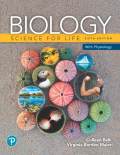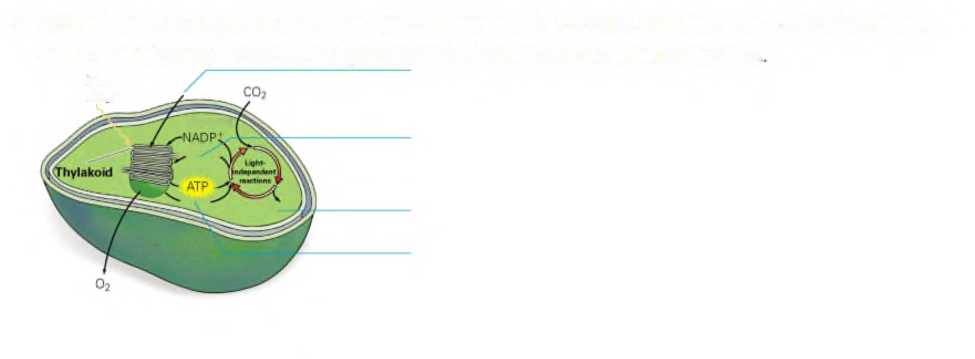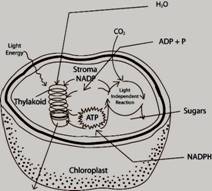
Concept explainers
Add labels to the figure that follows, which illustrates the product and reactants of photosynthesis and the relationship between its light reactions and light-independent reactions.

To label:
The given figure, which illustrates the product and reactants of photosynthesis and the relation between its light reaction and light-independent reactions.
Introduction:
Photosynthesis is a phenomenon that changes solar energy to chemical energy needed by all living organisms. Photosynthesis occurs in chloroplasts that found in the green part mainly in leaves of the plants.
Explanation of Solution
Photosynthesis can be broken down into two steps - light reaction and light-independent reaction.
Light reaction - Light reaction occurs when there is sunlight. Sunlight hits the chlorophyll molecule in the thylakoid membranes that excites electrons. These electrons are captured and passed through an electron transport chain that generates the energy-carrying molecules ATP. The electrons then transfer to the molecule NADPH. The electrons removed from chlorophyll in this way are replaced by those from water, which decompose to release them, a reaction that produces oxygen as a waste product.
Light-independent reaction - The ATP and the electrons in NADPH are utilized in the synthesis of sugar from CO2 in the second major step of photosynthesis called light-independent reactions. It occurs mainly in the stroma of the chloroplast and is sometimes referred to as the Calvin cycle.
The following labeled figure shows the products and reactants and the relation between its light-independent reaction and light reaction.

Fig:
The process of photosynthesis.
Thus, photosynthesis happens in two steps - light reaction and light-independent reaction.
Want to see more full solutions like this?
Chapter 5 Solutions
EBK BIOLOGY
- 18. Watch this short youtube video about SARS CoV-2 replication. SARS-CoV-2 Life Cycle (Summer 2020) - YouTube.19. What is the name of the receptor that SARS CoV-2 uses to enter cells? Which human cells express this receptor? 20. Name a few of the proteins that the SARS CoV-2 mRNA codes for. 21. What is the role of the golgi apparatus related to SARS CoV-2arrow_forwardState the five functions of Globular Proteins, and give an example of a protein for each function.arrow_forwardDiagram of check cell under low power and high powerarrow_forward
- a couple in which the father has the a blood type and the mother has the o blood type produce an offspring with the o blood type, how does this happen? how could two functionally O parents produce an offspring that has the a blood type?arrow_forwardWhat is the opening indicated by the pointer? (leaf x.s.) stomate guard cell lenticel intercellular space none of thesearrow_forwardIdentify the indicated tissue? (stem x.s.) parenchyma collenchyma sclerenchyma ○ xylem ○ phloem none of thesearrow_forward
- Where did this structure originate from? (Salix branch root) epidermis cortex endodermis pericycle vascular cylinderarrow_forwardIdentify the indicated tissue. (Tilia stem x.s.) parenchyma collenchyma sclerenchyma xylem phloem none of thesearrow_forwardIdentify the indicated structure. (Cucurbita stem l.s.) pit lenticel stomate tendril none of thesearrow_forward
- Identify the specific cell? (Zebrina leaf peel) vessel element sieve element companion cell tracheid guard cell subsidiary cell none of thesearrow_forwardWhat type of cells flank the opening on either side? (leaf x.s.) vessel elements sieve elements companion cells tracheids guard cells none of thesearrow_forwardWhat specific cell is indicated. (Cucurbita stem I.s.) vessel element sieve element O companion cell tracheid guard cell none of thesearrow_forward

 Concepts of BiologyBiologyISBN:9781938168116Author:Samantha Fowler, Rebecca Roush, James WisePublisher:OpenStax College
Concepts of BiologyBiologyISBN:9781938168116Author:Samantha Fowler, Rebecca Roush, James WisePublisher:OpenStax College Biology 2eBiologyISBN:9781947172517Author:Matthew Douglas, Jung Choi, Mary Ann ClarkPublisher:OpenStax
Biology 2eBiologyISBN:9781947172517Author:Matthew Douglas, Jung Choi, Mary Ann ClarkPublisher:OpenStax Biology (MindTap Course List)BiologyISBN:9781337392938Author:Eldra Solomon, Charles Martin, Diana W. Martin, Linda R. BergPublisher:Cengage Learning
Biology (MindTap Course List)BiologyISBN:9781337392938Author:Eldra Solomon, Charles Martin, Diana W. Martin, Linda R. BergPublisher:Cengage Learning Biology: The Dynamic Science (MindTap Course List)BiologyISBN:9781305389892Author:Peter J. Russell, Paul E. Hertz, Beverly McMillanPublisher:Cengage Learning
Biology: The Dynamic Science (MindTap Course List)BiologyISBN:9781305389892Author:Peter J. Russell, Paul E. Hertz, Beverly McMillanPublisher:Cengage Learning Biology Today and Tomorrow without Physiology (Mi...BiologyISBN:9781305117396Author:Cecie Starr, Christine Evers, Lisa StarrPublisher:Cengage Learning
Biology Today and Tomorrow without Physiology (Mi...BiologyISBN:9781305117396Author:Cecie Starr, Christine Evers, Lisa StarrPublisher:Cengage Learning





